
 |
California's Fiscal Outlook
|
It is important for the Legislature to be aware of the various factors which will influence the state's longer-term fiscal condition beyond 1998-99. This is especially true given the budget deficits (both on a current-year and year-end basis) we forecast for 1997-98 and 1998-99 (see Chapter 1). This chapter discusses some of these factors. As shown in Figure 1, they include demographic trends, economic developments, and future decisions by state and federal policy makers.
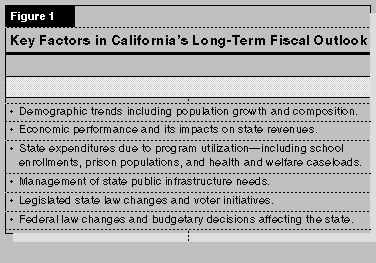
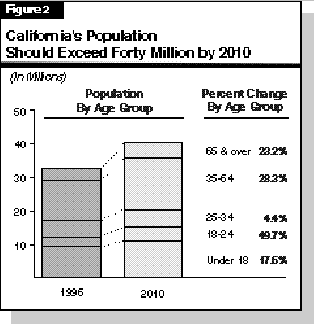
There also will be various other demographic changes occurring. For example, Figure 3 shows that the state's ethnic mix will be significantly changing.
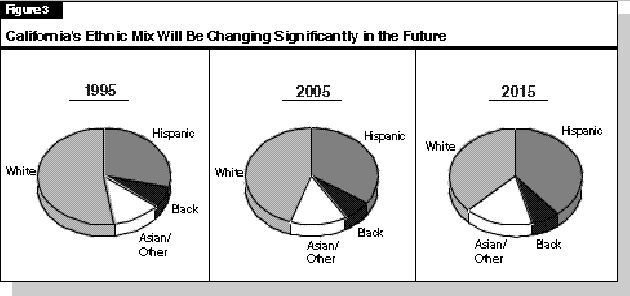
We believe that over the longer-term it is reasonable to assume the economy would on average experience moderate real growth and modest inflation. In this event, revenue growth would probably average in the general range of 5 percent to 6 percent annually (or about the same pace as state personal income), although growth in any given year could vary significantly. However, stronger or weaker economic growth and/or inflation could easily make average revenue growth be a percent or more different in either direction. As Figure 4 shows, General Fund revenues in 2006-07 would be about $80 billion under a moderate growth scenario. This amount, however, could be $10 billion higher or lower under realistic alternative scenarios.
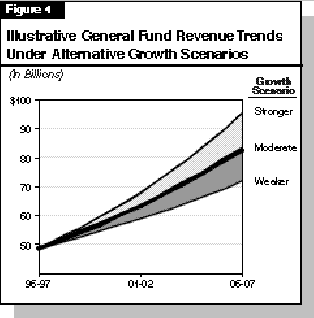
As an indication of the potential fiscal effects of a five-year limit, we estimate that if all recipients currently on aid for more than five years were eliminated from the caseload, the state would save $1.7 billion and the counties about $95 million annually from reduced grant expenditures (with no federal savings because the state is operating under a block grant). Because of the maintenance-of-effort provision in the TANF program, however, the state would have to redirect more than half of such savings into programs serving needy families with children. Furthermore, much of the state savings would be offset by costs to the counties due to increases in their General Assistance caseloads.
The state could also incur substantial savings from the provisions excluding noncitizens from SSI/SSP eligibility. Based on the assumptions that we used for our short-term forecast, we estimate that long-term savings would eventually level out at approximately $127 million annually. As is the case for the five-year limit on the TANF program, these savings would be offset by costs--potentially of a greater amount--to the counties' General Assistance program.
In summary, welfare reform could have a significant fiscal impact on the state and the counties. This will depend, however, on the specific actions taken by the Legislature and the Governor in response to the federal act.
Over the forecast period, we estimate that Proposition 98 will absorb a large proportion (over 60 percent) of new General Fund revenues each year. As a result, we forecast that the Proposition 98 (General Fund) share of revenues will increase from 38 percent in 1995-96 to 43 percent in 1998-99.
Beyond the forecast period, it is much more difficult to predict Proposition 98's share of the General Fund budget. Under the moderate economic growth scenario noted above, however, we think it is likely that Proposition 98's share of the budget will stabilize. Should the economy grow at a faster rate, the school's share of the budget would increase again.
Estimates of increased enrollments beyond 1998-99 are based in large part on projected increases in the young-adult population. As Figure 5 shows, for example, we project that the number of 18 year olds in California will increase by 78,000, or 19 percent, from 1996-97 to 2001-02, and by 186,000, or 45 percent, by the year 2015. These relatively large increases have been labeled by some as "Tidal Wave II" (the children of the "baby boomers").
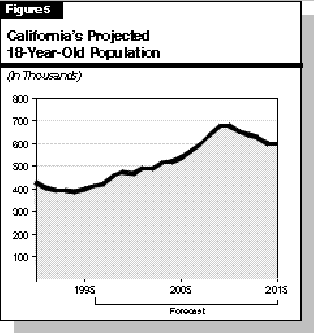
How these population numbers translate into increased higher education costs, however, is problematic. Apart from the uncertainties of projecting population growth generally, projecting growth in UC and CSU populations is complicated further by significant variability and uncertainty about the numbers of:
Each of these factors is influenced by general economic conditions, the educational goals and achievement of students, and the cost of various public and private educational opportunities.
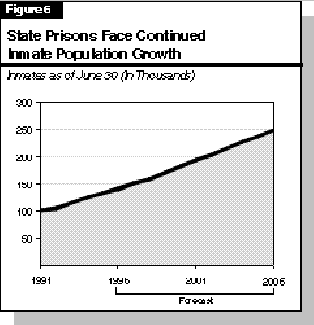
We estimate that if the significant growth in the inmate population persists, the CDC support budget would reach about $6.2 billion by 2005-06, or roughly double the present funding level, after adjusting for anticipated federal funds. The CDC budget would grow at an average annual rate of about 7.5 percent, compared with an annual 5.5 percent growth in revenues that would occur for the state General Fund under a moderate economic growth outlook during that same ten-year period. If the state accommodated this increased population by overcrowding existing prisons and building additional prison space, the state would incur one-time capital outlay costs of more than $3 billion to build as many as ten additional prisons. However, the cost of CDC operations and capital outlay could be lower if the Legislature or the courts took actions which either slowed inmate population growth or provided alternative forms of punishment for some offenders.
Figure 7 shows the capital outlay needs projected just for the next five years. It indicates that state agencies and K-12 education have identified needs totaling $39 billion over that period. Most of the identified projects fall in the areas of transportation, education, and corrections.
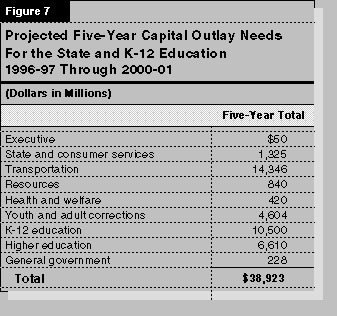
In recent years, the vast majority of capital outlay has been financed with state bonds. The major exception is transportation, which is financed primarily from state special funds and federal funds for transportation capital outlay. Presumably, future capital outlay projects would be similarly financed.